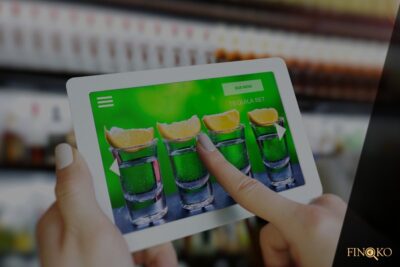Why Do Restaurants Need a CRM?
A Customer Relationship Management (CRM) system plays a crucial role in managing various aspects of a restaurant’s operations. In the fast-paced and competitive food industry, maintaining good relationships with customers is essential for success. This is where a CRM specifically designed for restaurants comes into play.

1. Managing Customer Data
A CRM for restaurants allows businesses to effectively collect, organize, and analyze customer data. This includes contact information, preferences, purchase history, feedback, and more. By centralizing this information, restaurants can gain valuable insights into their customers’ behavior and preferences.
With access to such data, restaurants can personalize their marketing efforts, tailor promotions, and offer targeted deals to specific customer segments. Understanding customer preferences also enables restaurants to create memorable dining experiences by providing personalized recommendations or offers based on past interactions.
2. Enhancing Customer Service
A CRM software provides restaurants with tools to deliver exceptional customer service. It helps streamline reservation management, allowing staff to efficiently handle bookings, track table availability, and manage special requests. By having access to customer preferences and previous visits, servers can provide personalized service that enhances the overall dining experience.
In addition, a CRM system can help restaurants effectively manage customer feedback and complaints. By tracking and addressing issues promptly, restaurants can improve their reputation and prevent negative reviews from spreading online.
3. Increasing Customer Loyalty and Retention
A CRM empowers restaurants to build strong relationships with their customers, leading to increased loyalty and retention rates. By understanding customers’ preferences and dining habits, restaurants can create targeted loyalty programs or rewards to encourage repeat visits.
A CRM system also enables personalized communication with customers through email marketing or SMS campaigns. Restaurants can send promotional offers, special event invitations, or even birthday greetings, fostering a sense of appreciation and engagement among their customer base.
4. Streamlining Operations
CRM software helps streamline various operational aspects of a restaurant. From inventory management to staff scheduling, a CRM system can provide insights and automate repetitive tasks, freeing up time for managers and employees to focus on delivering exceptional service.
Furthermore, by analyzing customer data, restaurants can make informed decisions regarding menu changes, pricing strategies, and marketing campaigns, resulting in improved profitability and efficiency.
A CRM system designed specifically for restaurants is essential for successful customer relationship management. By effectively managing customer data, enhancing customer service, increasing loyalty, and streamlining operations, restaurants can stay competitive in an industry driven by customer satisfaction.
Why is a Restaurant CRM Important?

A restaurant CRM helps achieve this by collecting and organizing customer information such as contact details, preferences, dining habits, and feedback. This data enables restaurateurs to personalize their marketing campaigns, tailor their menu offerings, and provide superior customer service.
Here are some key reasons why a restaurant CRM is essential:
- Enhanced Customer Communication: With a CRM system, restaurants can send targeted and personalized messages to their customers. This can include promotional offers, special discounts, event invitations, or even customized birthday greetings. By engaging customers on a more personal level, restaurants can build stronger relationships and foster loyalty.
- Improved Efficiency: Managing customer data manually can be time-consuming and prone to errors. A restaurant CRM automates various tasks like reservation management, order processing, and customer feedback collection. This not only saves valuable staff time but also ensures accuracy and consistency in data handling.
- Streamlined Operations: By integrating a CRM system with other restaurant management tools, such as point-of-sale (POS) systems or online ordering platforms, restaurants can centralize their operations. This allows for better coordination between departments, simplifies administrative tasks, and enhances overall efficiency.
- Personalized Offerings: A restaurant CRM enables establishments to gain insights into customer preferences and dining habits. This information can be utilized to create personalized menu recommendations or suggest specific dishes based on previous orders. By tailoring offerings to individual tastes, restaurants can provide a more memorable dining experience.
- Effective Feedback Management: Feedback plays a crucial role in improving restaurant operations. With a CRM system, restaurateurs can collect customer feedback through surveys, online reviews, or social media interactions. Analyzing this feedback helps identify areas for improvement, address customer concerns, and continually enhance the overall dining experience.
Increasing Retention in an Uncertain Economy with Restaurant CRM
In today’s uncertain economy, restaurants face various challenges in retaining customers. However, with the help of Customer Relationship Management (CRM) software specifically designed for the restaurant industry, it is possible to increase customer retention and build long-term loyalty.
Here are some effective ways to use customer data software for increasing retention:
- Segmentation: Group customers based on their preferences, demographics, or dining habits. This allows you to tailor marketing campaigns and offers to specific segments, increasing the relevance and effectiveness of your messages.
- Personalized Marketing: Leverage customer data to send personalized communications, such as birthday discounts, anniversary offers, or recommendations based on past orders. Demonstrating that you understand and care about your customers’ individual needs creates a strong bond and increases the chances of repeat visits.
- Loyalty Programs: Implement a loyalty program integrated with your CRM system to reward frequent customers. By tracking their rewards and offering exclusive benefits, you can motivate customers to choose your restaurant over competitors.
- Feedback Management: Use CRM software to collect and manage customer feedback. Encourage customers to provide reviews and suggestions, and actively respond to their comments. This shows that you value their opinions and are committed to continuously improving their dining experience.
- Targeted Promotions: Analyze customer data to identify patterns and preferences. With this information, you can create targeted promotions or discounts that align with what your customers are likely to be interested in. This increases the chances of converting potential customers into loyal patrons.
From segmentation and personalized marketing to loyalty programs and targeted promotions, the possibilities with CRM are vast. Embrace this technology to stay competitive and keep customers coming back even in challenging economic times.
Choosing the Right CRM Software

When selecting a restaurant CRM software, it is important to consider factors such as ease of use, scalability, integration capabilities, and affordability. Additionally, look for features that cater specifically to the needs of the foodservice industry, such as reservation management, table layout planning, loyalty program support, and order tracking.
Ultimately, a restaurant CRM can be a powerful tool in today’s competitive market. It empowers businesses to better understand their customers, streamline operations, and deliver an exceptional dining experience. By investing in a suitable CRM solution, restaurants can effectively manage customer data and build long-lasting relationships with their patrons.
Here are some common features of restaurant CRM software:
1. Customer Database Management
A robust CRM software helps restaurants maintain a comprehensive database of customer information. This includes details like contact information, preferences, order history, feedback, and more. With this information at their fingertips, restaurant staff can offer personalized experiences to customers, including tailored marketing campaigns, special promotions, and individualized recommendations.
2. Reservation Management
Restaurant CRM software often includes a reservation management feature, allowing staff to efficiently handle table bookings. This feature enables the capture of customer information during the reservation process, making it easier to identify and cater to specific needs or preferences of guests. It also helps track seating availability, optimize table utilization, and minimize wait times.
3. Loyalty Programs
Loyalty programs are an effective way for restaurants to reward their frequent customers and encourage repeat visits. CRM software allows restaurants to create and manage loyalty programs easily. By integrating loyalty programs within the CRM system, it becomes convenient to track customer participation, points accumulation, and redemption. This helps in building strong customer relationships while boosting customer retention.
4. Feedback and Review Management
Collecting and analyzing customer feedback is essential for improving restaurant operations. Restaurant CRM software often includes features for managing customer reviews and feedback. It enables restaurants to monitor online reviews, respond promptly to customer complaints or suggestions, and take necessary actions to address any concerns. This helps in maintaining customer satisfaction and enhancing the overall dining experience.
5. Marketing and Campaign Management
A robust CRM solution offers restaurants the ability to create targeted marketing campaigns and promotions. By leveraging customer data, restaurants can segment their customer base and send personalized offers via email or SMS. This feature allows for effective customer communication, promoting special events, new menu items, discounts, and other initiatives.
6. Integration with POS Systems
Integration with Point of Sale (POS) systems is a crucial feature of restaurant CRM software. This allows for seamless data exchange between the CRM system and the POS, enabling real-time information updates on orders, payments, and inventory. The integration streamlines operations, eliminates manual data entry, and provides accurate insights into sales performance and customer behavior.
7. Reporting and Analytics
Restaurant CRM software often includes reporting and analytics capabilities to help businesses gain valuable insights. With these features, restaurants can track key performance indicators such as customer acquisition costs, customer lifetime value, repeat visit rates, and more. These insights enable data-driven decision-making, allowing restaurants to optimize their operations and marketing strategies.
Successful CRM Implementation Plan: 7 Step Strategy Process

Implementing a customer relationship management (CRM) system can revolutionize the way restaurants handle customer data and improve their overall operations. However, a successful CRM implementation requires careful planning and execution.
1. Assess Your Data
Take an inventory of your existing customer data and evaluate its quality and accuracy. Cleanse and organize the data before migrating it to the CRM system to ensure optimal functionality and data integrity.
2. Choose the Right CRM System
Research different CRM software options available in the market and select one that aligns with your restaurant’s specific needs. Consider factors like ease of use, integration capabilities, scalability, and cost-effectiveness.
3. Customize the CRM Solution
Once you have chosen the CRM system, tailor it to suit the unique requirements of your restaurant. Configure fields, workflows, and reporting functionalities to reflect your business processes accurately.
4. Provide Adequate Training
Ensure all staff members who will be using the CRM software receive comprehensive training. This will help them understand how to utilize the system effectively, ensuring maximum utilization and adoption.
5. Integrate with Existing Systems
If you have other systems in place such as POS software or reservation systems, integrate them with your CRM system. This integration will allow for seamless data flow and provide a holistic view of customer interactions.
6. Monitor and Analyze Performance:
Regularly monitor key performance indicators (KPIs) related to your CRM implementation. Analyze metrics such as customer satisfaction, sales growth, and customer retention rates to assess the impact of the CRM system.
7. Continuously Improve:
CRM implementation is an ongoing process. Gather feedback from staff and customers to identify areas of improvement. Make necessary adjustments to workflows or functionalities to enhance the effectiveness of your CRM system.
A successful CRM implementation plan for restaurant customer data software involves defining objectives, assessing current data, selecting the right CRM system, customizing it, providing adequate training, integrating with existing systems, establishing data governance policies, implementing data security measures, monitoring performance, and continuously improving. By following these steps, restaurants can unlock the full potential of CRM software and optimize their customer relationships.